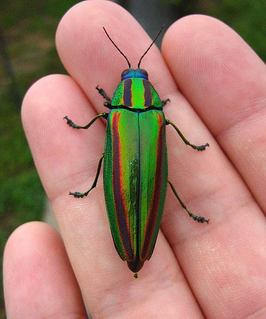
The family Scarabaeidae as currently defined consists of over 30,000 species of beetles worldwide, often called scarabs or scarab beetles. The classification of this family has undergone significant change in recent years. Several subfamilies have been elevated to family rank, and some reduced to lower ranks. The subfamilies listed in this article are in accordance with those in Bouchard (2011).

Elateriformia is an infraorder of polyphagan beetles. The two largest families in this group are buprestids, of which there are around 15,000 described species, and click beetles, of which there are around 10,000 described species.
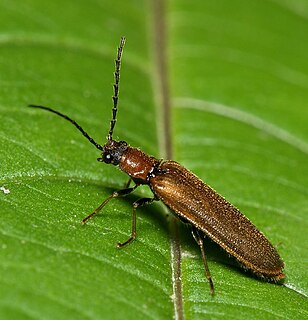
The Elateroidea are a large superfamily of beetles. It contains the familiar click beetles, fireflies, and soldier beetles and their relatives.

Buprestoidea is a superfamily of beetles.

The term woodboring beetle encompasses many species and families of beetles whose larval or adult forms eat and destroy wood. In the woodworking industry, larval stages of some are sometimes referred to as woodworms. The three most speciose families of woodboring beetles are longhorn beetles, bark beetles and weevils, and metallic flat-headed borers.

The family Oedemeridae is a cosmopolitan group of beetles commonly known as false blister beetles, though some recent authors have coined the name pollen-feeding beetles. There are some 100 genera and 1,500 species in the family, mostly associated with rotting wood as larvae, though adults are quite common on flowers.

Cicindela, commonly known as common tiger beetles are generally brightly colored and metallic beetles, often with some sort of patterning of ivory or cream-colored markings. They are most abundant and diverse in habitats very often near bodies of water with sandy or occasionally clay soils; they can be found along rivers, sea and lake shores, sand dunes, around dry lakebeds, on clay banks, or woodland paths.

Beetlewing, or beetlewing art, is an ancient craft technique using iridescent beetle wings practiced traditionally in Thailand, Myanmar, India, China and Japan.

Chalcophora japonica, or ubatamamushi in Japanese, also known as the flat-headed wood-borer, is a metallic, bullet-shaped, woodboring beetle of the Buprestidae family. It is endemic to Japan.

Mutinus elegans, commonly known as the elegant stinkhorn, the dog stinkhorn, faeces carota, the headless stinkhorn, or the devil's dipstick, is a species of fungus in the Phallaceae family. A saprobic species, it is typically found growing on the ground singly or in small groups on woody debris or leaf litter, during summer and autumn in Japan, Europe, and eastern North America. The fruit body begins its development in an "egg" form, resembling somewhat a puffball partially submerged in the ground. As the fungus matures, a slender orange to pink colored stalk emerges that tapers evenly to a pointed tip. The stalk is covered with a foul-smelling slimy green spore mass on the upper third of its length. Flies and other insects feed upon the slime which contains the spores, assisting in their dispersal. Due to their repellent odor, mature specimens are not generally considered edible, although there are reports of the immature "eggs" being consumed. In the laboratory, Mutinus elegans has been shown to inhibit the growth of several microorganisms that can be pathogenic to humans.

Chrysochroa rajah is a Jewel Beetle or Metallic Wood-boring Beetle of the Buprestidae family.

Chrysochroa buqueti, the red speckled jewel beetle, is a Southeast Asian species of beetle in the Buprestidae family.
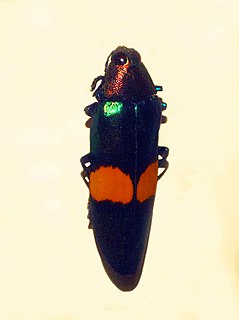
Chrysochroa edwardsii is a Jewel Beetle or Metallic Wood-boring Beetle of the Buprestidae family.
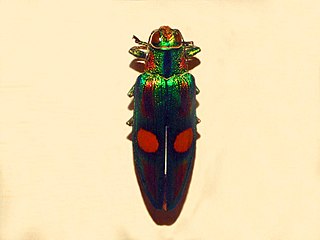
Chrysochroa ocellata is a Jewel Beetle or Metallic Wood-boring Beetle of the Buprestidae family.
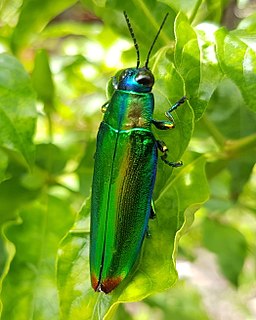
Chrysochroa fulminans is a species of jewel beetle of the Buprestidae family.
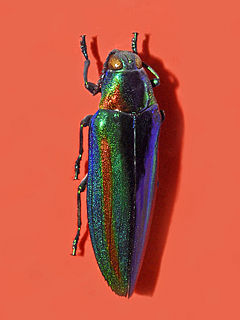
Chrysochroa vittata is a species of beetle in the Buprestidae family.

Insects have found uses in art, as in other aspects of culture, both symbolically and physically, from ancient times. Artforms include the direct usage of beetlewing (elytra) in paintings, textiles, and jewellery, as well as the representation of insects in fine arts such as paintings and sculpture. Insects have sometimes formed characteristic features of artforms, as in Art Nouveau jewellery.

